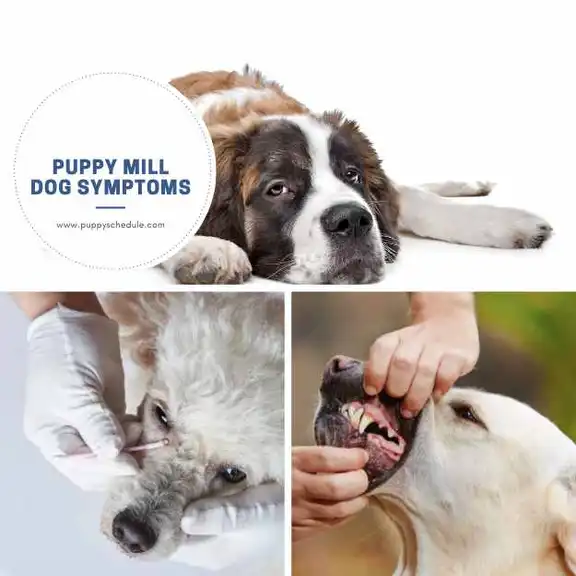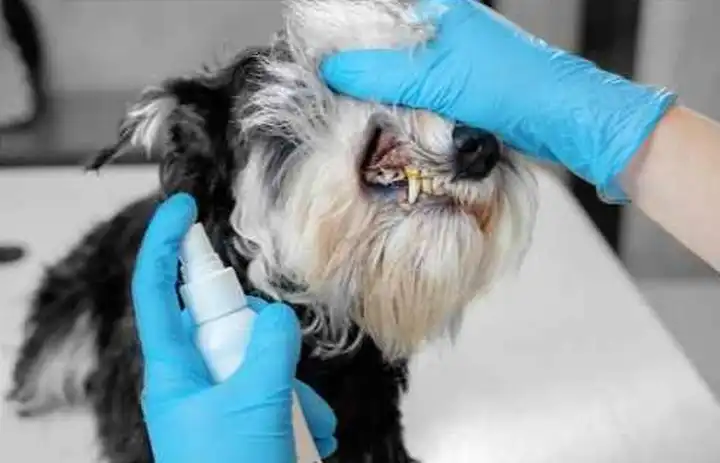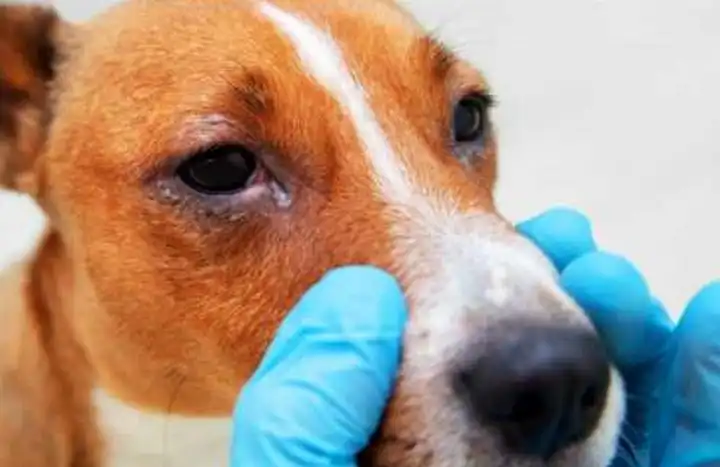Understanding Puppy Mill Dog Symptoms, Care, and Identification: Puppy mills are commercial dog breeding facilities prioritizing profit over animal welfare. Dogs in puppy mills are often kept in unsanitary and overcrowded conditions, with little to no access to proper food, water, or medical care.
As a result, puppy mill dogs frequently suffer from a range of physical and behavioral problems that can affect their health and quality of life. In this article, we’ll explore the puppy mill dog symptoms, how to identify them, and provide them with the care and attention they need.
Puppy Mill Dog Symptoms

According to the Humane Society of the United States, it is calculated that there are about 10,000 puppy mills in the United States, having more than 2 million puppies each year. Many facilities need proper licensing or oversight, making regulating and monitoring their activities easier.
Physical symptoms
Puppy mill dogs often exhibit various physical symptoms due to poor living situations. These can include:
- Matted fur and a dirty coat
- Overgrown nails
- Dental problems
- Skin irritations and infections
- Eye and ear infections
- Respiratory problems
- Gastrointestinal issues
Behavioral symptoms
Dogs from puppy mills often exhibit physical and behavioral symptoms related to their past living conditions.
To help readers better understand the puppy mill dog symptoms, let’s take a look at some real-life examples:
Matted fur and a dirty coat
Puppy mill dogs are usually held in cramped and unsanitary conditions, leading to matted fur and dirty coats. It can be especially problematic for dogs with long hair, as mats can become painful and cause skin irritation. In severe cases, matting can even restrict movement and cause infections.
Dental problems
Dogs in puppy mills are often fed poor-quality diets and may not have access to proper dental care. It can lead to dental issues such as gum disease, tooth decay, and infections. Left untreated, dental problems can cause significant pain and even lead to more severe health issues.
Respiratory problems
Puppy mill dogs may be kept in poorly ventilated spaces or exposed to toxic fumes from chemicals used to clean their living areas. It can lead to respiratory problems such as coughing, wheezing, and problem breathing.
Fear and anxiety
Puppy mill dogs may be fearful and anxious due to their past living conditions. It can make adjusting to new people and environments challenging, causing them to exhibit fearful or aggressive behavior.
Aggression
Some puppy mill dogs may exhibit aggression towards humans or other dogs due to fear and lack of socialization. It can be especially problematic for dogs mistreated or subjected to cruel living conditions.
Care for Puppy Mill Dogs

Caring for a puppy mill dog requires patience, understanding, and specialized knowledge of their unique needs. Here are some tips for caring for a puppy mill dog:
- Consult with a veterinarian: Puppy mill dogs may have various health problems that require medical attention. Consult a veterinarian to create a treatment plan and provide your dog is up-to-date vaccinations.
- Provide a safe and comfortable environment: Puppy mill dogs may be fearful or anxious in new environments. Provide a safe, quiet space where your dog can feel secure.
- Be patient: Puppy mill dogs may require additional training and socialization to overcome the effects of their past living conditions. Be patient and understanding, and desire the assistance of a professional trainer if necessary.
- Seek support: Adopting a puppy mill dog can be challenging, but many resources are available to help. Look for support groups and organizations specializing in rehabilitating and rehoming dogs from puppy mills.
History and Prevalence of Puppy Mills
Puppy mills have been a problem in the United States for decades. In the 1960s and 70s, commercial dog breeding operations began to boom, driven by the demand for purebred dogs. Over time, these facilities became increasingly overcrowded and unsanitary, leading to widespread health problems among the dogs they bred.
Today, the exact number of puppy mills in the United States is unknown, but it’s estimated that there are thousands of these facilities nationwide. Many puppy mills operate without proper licensing or oversight, making regulating and monitoring their activities difficult.
Legal and Ethical Issues Surrounding puppy mill dog symptoms

The conditions in puppy mills are often inhumane and violate basic animal welfare standards. However, despite efforts to regulate these facilities, they continue to operate and profit from the sale of puppies.
Many states have laws that regulate commercial dog breeding operations, but these laws often need to be stronger or more enforced. In addition, the internet has made it easier for puppy mills to sell their puppies directly to consumers, circumventing traditional pet store regulations.
Recently, a growing movement has raised awareness about puppy mill dog symptoms and advocated for stronger laws and regulations to protect dogs from these facilities.
How to identify a puppy mill dog symptoms

Identifying a puppy mill dog can be challenging, as they may look similar to other dogs. However, there are a few signs that can help you spot a puppy mill dog, including:
- Age: Puppy mill dogs are often sold very young before they have received proper socialization and training.
- Health: Puppy mill dogs may appear sickly, with dirty coats and signs of neglect.
- Breeding history: If a dog has had multiple litters or has been bred too frequently, it may be a sign that the dog is from a puppy mill.
- Behavior: Puppy mill dogs may exhibit fearful or aggressive behavior or seem overly submissive or withdrawn.
Treating puppy mill dog symptoms

Medical treatment
Puppy mill dogs require immediate medical attention to address any physical health problems.
It may include a veterinary exam, vaccinations, spaying or neutering, dental cleaning, and infection or injury treatment.
Dogs from puppy mills often suffer from various health problems due to neglect and mistreatment. As such, it is essential to provide them with prompt medical attention to address their physical health concerns. It typically involves a veterinary exam, administering vaccines, sterilization surgery, teeth cleaning, and treatment of any injuries or infections.
Veterinary Exam
The first step in treating puppy mill dogs is a thorough veterinary exam. A veterinarian will assess the dog’s overall health and identify immediate issues. The exam may involve a physical examination, blood work, and other diagnostic tests, such as x-rays.
Vaccinations
Dogs from puppy mills are often not vaccinated, leaving them vulnerable to various illnesses. As such, it’s crucial to ensure they receive all necessary vaccinations to protect them from common diseases such as rabies, distemper, and parvo.
Sterilization Surgery
Spaying or neutering a dog is an essential part of responsible pet ownership. It helps prevent unwanted litter and reduces the risk of certain health problems like reproductive cancers. Sterilization surgery is also important in treating puppy mill dogs, as it can help reduce behavior problems, such as aggression and marking.
Teeth Cleaning
Dental hygiene is critical to a dog’s overall health, and puppy mill dogs often suffer from neglected dental care. A dental cleaning can help prevent tooth decay, gum disease, and other oral health problems which can impact a dog’s overall health.
Infection or Injury Treatment
Puppy mill dogs may have untreated injuries or infections that require medical attention.
Common issues include skin infections, ear infections, and injuries from cramped and unsanitary conditions.
Treatment may involve medication, wound care, and in some cases, surgery.
Behavioral treatment puppy mill dog symptoms
Dogs may also require behavioral treatment to address their anxiety, fear, and other behavioral issues. It can include socialization and training to help the dog adjust to new surroundings and learn appropriate behaviors.
Puppy mill dogs often suffer from behavioral issues due to their past traumatic experiences. They may struggle with anxiety, fear, aggression, and other behavioral issues, making it challenging to adjust to new environments and form positive relationships with humans and other animals. As such, behavioral treatment is critical in helping these dogs recover and thrive in their new homes.
Socialization
Socialization is a crucial component of behavioral treatment for puppy mill dogs. Many of these dogs have never experienced positive interactions with humans, other dogs, or new environments. Socialization involves exposing them to various positive experiences, such as meeting new people and dogs, going for walks, and exploring new environments. Socialization helps these dogs develop confidence, trust, and positive associations with new experiences.
Training
Training is another important aspect of behavioral treatment for puppy mill dogs. Many of these dogs have never received basic obedience training and may struggle with commands such as “sit” and “stay.” Training can help these dogs learn appropriate behaviors and provide mental stimulation to improve their well-being. Positive reinforcement training techniques, such as clicker training, can be especially effective in helping these dogs learn new behaviors.
Addressing Anxiety and Fear
Puppy mill dogs often struggle with anxiety and fear, manifesting as destructive behaviors, aggression, and other problematic behaviors. Behavioral treatment can help these dogs overcome their fears and anxiety through techniques such as counter-conditioning and desensitization. Counter-conditioning involves associating positive experiences with previously fearful stimuli, while desensitization involves gradually exposing the dog to stimuli that trigger fear or anxiety.
Patience and Understanding
It’s important to approach behavioral treatment for puppy mill dogs with patience, understanding, and compassion. These dogs have endured significant trauma; it can take time to trust humans and adjust to new environments. Consistency and positive reinforcement are essential in helping these dogs overcome their behavioral issues and develop healthy, positive relationships with their new families.
How to adopt a puppy mill dog
Adopting a puppy mill dog can be a rewarding experience, but it’s important to understand the potential challenges that come with it. Dogs raised in puppy mills may have physical and behavioral issues due to their previous living conditions.
Before adopting a puppy mill dog, it’s important to research and finds a reputable rescue organization specializing in rehabilitating and rehoming dogs from puppy mills. These organizations can provide support and resources to help you navigate the challenges of adopting a dog with a traumatic past.
When adopting a puppy mill dog, it’s important to be patient and understanding. Your new dog may be scared or anxious in their new environment and need time to adjust to their new home and family. Providing a safe and loving environment and proper training and socialization can help your dog overcome their past and become a happy and healthy pet.
If you’re considering adopting a puppy mill dog, educate yourself about their specific needs and work with a qualified professional to help you provide the best possible care for your new pet.
Pros
Adopting a puppy mill dog can be a rewarding experience, but it also requires careful consideration. Some potential pros of adopting a puppy mill dog include the following:
- Saving a dog from a life of neglect and cruelty: By adopting a puppy mill dog, you allow them to escape the harsh conditions of a breeding facility and live in a safe, loving home.
- Providing a loving home for a needy dog: Puppy mill dogs often lack socialization and human interaction, making them crave love and attention. By adopting one, you can give them the affection they deserve.
- Forming a strong bond with a dog with trust issues: Due to their difficult past, puppy mill dogs may struggle to trust humans. However, with patience and understanding, you can help them overcome their fears and build a strong bond.
Cons
However, there are also potential cons to adopting a puppy mill dog, including:
- The need for extensive medical and behavioral treatment: Puppy mill dogs often suffer from a range of physical and behavioral problems that require specialized treatment.
- Uncertainty about the dog’s breed or health history: Due to the need for proper record-keeping in puppy mills, it can be difficult to determine a dog’s breed or health history.
- The possibility of ongoing health or behavioral problems: Even with proper medical and behavioral treatment, some puppy mill dogs may continue to experience health or behavioral issues for the rest of their lives.
What to consider before adopting
Before adopting a puppy mill dog, it’s important to consider a few key factors:
- Your ability to provide the necessary care and attention: Puppy mill dogs often require extra attention and care, including regular veterinary checkups, socialization, and training.
- The dog’s specific medical and behavioral needs: Before adopting a puppy mill dog, ensure you understand their specific medical and behavioral needs and can provide the necessary care.
- Your lifestyle and living situation: Consider whether your lifestyle and living situation is conducive to caring for a puppy mill dog. For example, if you live in an apartment, consider whether you have enough space for the dog to exercise and play.
- The potential medical and behavioral treatment costs: Adopting a puppy mill dog can be costly, as they often require extensive medical and behavioral treatment.
By carefully considering these factors, you can determine whether adopting a puppy mill dog is the right choice for you and your family.
If you decide to adopt, be patient and understanding, as it may take some time for your new furry friend to adjust to their new home and overcome their past experiences. You can give a puppy mill dog a second chance at a happy and healthy life with proper care and love.
How to report suspected puppy mills
If you suspect that a breeder is operating a puppy mill or is engaging in animal cruelty, there are actions you can take to report them and help protect the animals involved. Here’s what to do:
Gather information
Before reporting it, gather as much data as potential, including:
- The name and location of the breeder: If you understand the name and location of the breeder, note it.
- The number and breed of dogs: Count the number of dogs on the property and note their breeds.
- The condition of the dogs: Take note of their living conditions, including whether they have access to food, water, and shelter.
- Any signs of neglect or abuse: Look for signs of neglect or abuse, such as malnourishment, injuries, or lack of medical care.
You can report the breeder to the appropriate authorities, which may include:
- Local law enforcement: Contact them, such as the police or sheriff’s department.
- Animal control: Call them for other animal welfare violations.
- The Humane Society of the United States: Call your local authorities or suspect that a puppy mill is used across state lines. You can reach The Humane Society.
When reporting, provide as much detail as possible, including the breeder’s name and location, the number and breed of dogs, and any signs of neglect or abuse you observed. The more information you can provide, the better-equipped authorities will be to analyze and take appropriate action.
Spread awareness
In addition to reporting suspected puppy mills to the appropriate authorities, you can also help raise awareness about the issue by sharing information with your friends and family and supporting organizations that work to end puppy mills and promote animal welfare. By working together, we can help protect dogs from the cruelty of puppy mills and ensure that they are treated with the care and respect they deserve.
Conclusion
Puppy mill dogs require specialized care and attention to address their physical and behavioral problems. If you’re considering adopting a puppy mill dog, it’s important to research and prepares for the unique challenges of providing a home for a dog who has suffered from neglect and abuse. With patience, love, and the right resources, you can provide a safe and happy home for a needy puppy mill dog.



